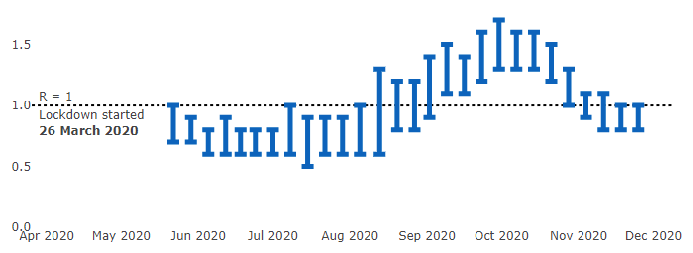Coronavirus (COVID-19): framework for decision making - assessing the four harms
Sets out the four harms process for assessment used to establish when coronavirus restrictions could be safely lifted after lockdown and the scientific evidence underpinning the decisions.
The R value
How do we measure the spread of the epidemic?
What is R?
The R value, or reproduction number, is a way of assessing a disease's ability to spread. It is the number of people, on average, that one infected person will infect.
We use data such as the number of people testing positive or admitted to hospital to help us work out the R number. If the R number is above one, then the number of cases could start to increase exponentially, but if it is lower than one the disease will decline. It is, therefore, important that we keep the R number consistently below one. If we do not, the virus will quickly spread and any relaxation of restrictions will most likely have to be reversed. A sustained increase of R above one would indicate an exponential growth in the number of cases, hospitalisations and deaths, potentially causing very significant harm to Scotland's health, society and economy, particularly if the prevalence is also high.
A related concept, the doubling time is the time it takes for the number of new infections to double in size.
What affects R?
The basic reproduction number is affected by several factors:
- The underlying infectiousness of the organism;
- How long people who have COVID-19 can infect others;
- The number of people in the population that the affected patients are in contact with and how intense that contact is;
- If policies have the effect of reducing the number of people someone comes into contact with, that would in turn reduce R; and
- Other factors affecting R include the degree of compliance with restrictions and mitigating measures (behaviour) and the effectiveness of the Test & Protect regime.
How do we measure R?
The R value in the Scottish Government's Coronavirus (COVID-19): Framework for Decision Making uses and adapts modelling outputs from a number of academic groups to estimate the R value for Scotland at a particular point in time.[34] It is calculated through modelling of the path of the virus in Scotland. The epidemiological progression in the Scottish Government model is simulated using one of the publicly available Imperial College COVID-19 models as used for UK level modelling. This uses data on deaths published by National Records of Scotland[35] and other data such as contact patterns from the Scottish Contact Survey. Weekly published updates on R at a particular point in time are available in our research series Coronavirus (COVID-19) modelling the epidemic.[36]
R has varied over time as shown in Figure 8. The current range for R in Scotland (early Dec 2020) is between 0.8 and 1.0. This is unchanged from the previous week,

Source: Scottish Government – Modelling the Epidemic[37]
In addition to the modelling, there are other ways to use data to measure the epidemic. Some of this work is carried out by Public Health Scotland, with support from Strathclyde University. They can analyse NHS 24 calls, positive tests, the change in the volume of calls and tests across the country each week, community surveillance of COVID-19 symptoms, and hospitalisation measures (admissions, bed numbers, ICU and deaths). Further surveillance including swab tests (e.g. in dental surgeries) and sero-prevalence in blood samples is undertaken. Excess mortality, and hospital outcomes (including deaths) are also monitored. Remnants of the virus are now also being monitored in wastewater, by SEPA and Scottish Water.[38] This range of work presents information on what variations and changes in the genome of SARS-CoV-2 tell us about virus evolution and patterns in transmission regarding the Cov2 strains currently in circulation in Scotland.
Contact
Email: covidexitstrategy@gov.scot
There is a problem
Thanks for your feedback